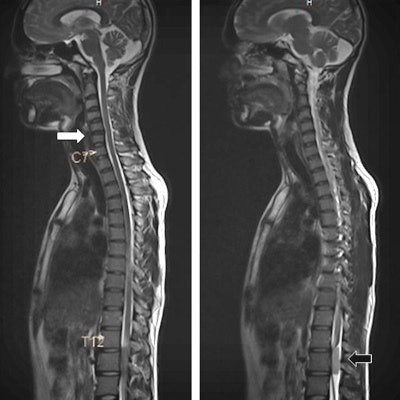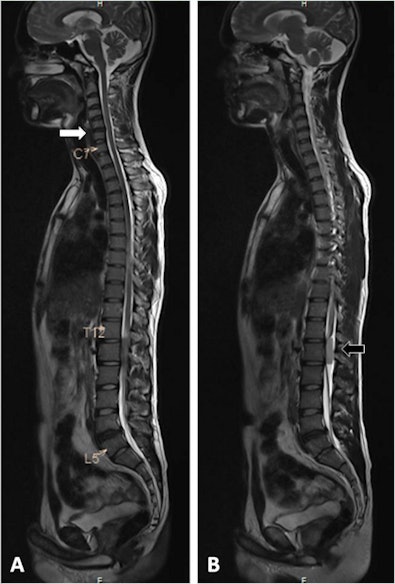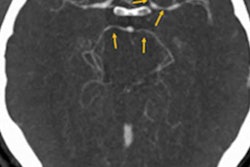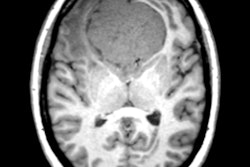
Whole-spine sagittal MRI of patients with degenerative diseases often can detect significant incidental findings, according to a study with nearly 1,500 patients and published in the European Spine Journal. Many findings drastically alter patient management through surgical intervention, mandatory follow-up, or necessitating a specialist opinion.
The efficacy of whole-spine T2-weighted sagittal screening in providing additional information has been demonstrated in several spinal diseases, but its routine use in patients with spinal degenerative diseases has not been studied, according to lead author Dr. Rishi Kanna, associate consultant spine surgeon at Ganga Hospital in Coimbatore, India, and colleagues. They believe this is the first time the usefulness of routine whole-spine screening MRI with standard MRI of specific spinal regions has been identified in these patients.
 This 42-year-old male patient presented with axial neck pain and right upper-limb radiculopathy. Whole-spine T2-weighted sagittal screening images (a, b) show mild disk bulge at C5-6 (white arrow), and an intradural extramedullary tumor behind the body of L1 vertebra (black arrow). Image courtesy of Dr. Rishi Kanna and European Spine Journal.
This 42-year-old male patient presented with axial neck pain and right upper-limb radiculopathy. Whole-spine T2-weighted sagittal screening images (a, b) show mild disk bulge at C5-6 (white arrow), and an intradural extramedullary tumor behind the body of L1 vertebra (black arrow). Image courtesy of Dr. Rishi Kanna and European Spine Journal.The group aimed to show how detailed images of the spinal column and adjacent spinal regions and paravertebral organ systems can reveal asymptomatic yet significant incidental findings.
The authors retrospectively reviewed 1,486 consecutive T2-weighted whole-spine MRI scans performed as an adjunct to cervical, thoracic, or lumbar spinal imaging for degenerative diseases, and documented the incidence and significance of asymptomatic incidental findings in the spinal and extraspinal regions.
The patients were evaluated at Ganga Hospital between January and December 2015 for one of the following spinal symptoms: axial lower-back pain, mid-back pain, neck pain, upper-limb radiculopathy, and lower-limb radiculopathy. Region-specific MRI scans of the cervical, thoracic, and lumbar spine were performed based on the patient's primary symptom. The primary area evaluated included the cervical spine in 9.64%, thoracic spine in 2.63%, and lumbar spine in 87.71% of patients. In addition, T2-weighted whole-spine sagittal MR screening was routinely performed in all 1,486 patients.
The study revealed that 236 (15.88%) patients had incidental findings and 65 (27.5% of 236) of these incidental findings were significant, necessitating either surgery or specialist intervention. (European Spine Journal, 21 January 2017)
Clear results
Specifically, 236 (15.88%) patients had incidental findings with a male/female ratio of 102/134 and a mean age of 50.3 years.
The authors demonstrated that routine T2-weighted whole-spine MRI identified incidental findings of the spinal and extraspinal regions in 15.8% of patients, and 65 (4.3% of 1,486) patients required either spine surgical intervention or other specialist care.
The key findings are shown below:
| Total patients reviewed n = 1,486 (100%) | |
| Total incidental findings | 236 (15.88%) |
| Total significant incidental findings | 65 (27.5% of 236, and 4.3% of 1,486) |
| Incidental finding requiring no action | 171 (72.5% of 236, and 11.5% of 1,486) |
| Vertebral column incidental findings | 122 (51.7% of 236) |
| Surgery required for vertebral column incidental findings | 33 (2.2% of 1,486) |
| Extraspinal incidental findings | 114 (48.3% of 236) |
| Further specialist or surgical evaluation for extraspinal incidental findings required | 32 (2.1% of 1,486) |
The researchers further analyzed the findings by dividing the patients into two groups based on the location of their incidental findings: Group A included 122 patients (51.7%) with incidental findings in the spine, while group B included 114 patients (48.3%) and had extraspinal incidental findings.
In group A, 84 patients had incidental findings in the vertebral column and 38 patients had incidental findings in the spinal cord. Incidental findings within the spine included vertebral hemangioma (n = 60, 4.5%), diffuse vertebral marrow changes (n = 18, 1.2%), vertebral metastasis (n = 2), incidental cord myelopathy (n = 21), intradural tumor (n = 7), and others. A total of 33 patients required surgical intervention for their incidental findings (2.2%).
In group B, pelvic incidental findings were most prevalent (n = 79, 5.3%) followed by retroperitoneal abdominal findings in 22 (1.48%), and intracranial incidental findings in 9 (0.60%). A total of 32 (2.1%) of these pathologies required further specialist medical or surgical evaluation.
Ready for routine use?
Do the findings indicate that whole-spine MRI screening of patients with degenerative spinal diseases is ready for routine use? Maybe, but challenges to consider include rising healthcare costs, lack of universal availability of MRI, and longer scanning time.
"Many of the incidental findings in this study (171/236) required no further action. In addition, while 33 patients with incidental findings required spine surgical intervention, the outcome of those incidental findings which were followed up under other specialists was not evaluated in this study," the authors wrote.
That said, they also pointed to positive impact of finding incidental lesions at an early stage, and believed that medical care could be improved significantly.
For example, at Ganga Hospital, T2-weighted whole-spine sagittal MR screening is routinely performed in all degenerative spine patients, along with region-specific spine MRI as a standard protocol.
There has been an increased recognition of the importance of early diagnosis and management of spinal degenerative diseases recently in India, Kanna told AuntMinnieEurope.com in an email. This is because of the rise in the country's aging population, better access to healthcare and imaging facilities, and improved understanding among the public and healthcare personnel about spinal disorders.
 Dr. Rishi Kanna from Coimbatore, India.
Dr. Rishi Kanna from Coimbatore, India."The most important finding in our study is the significant incidence of asymptomatic incidental findings in other spinal regions and paraspinal organs, when a whole-spine screening sequence is performed in addition to standard regional MRI. Considering the potential advantages in identifying significant [incidental findings] and the minimal extra time spent performing whole-spine MRI, it can be considered for routine imaging of spinal degenerative diseases," he pointed out.
The additional whole-spine MRI procedure takes only about 1.5 to 2 minutes, and, along with a complete evaluation of a particular spinal region, has become standard practice in many radiological centers in India, according to Kanna.
"I think radiologists play a significant role in the diagnosis of incidental findings, especially of the pelvis, paraspinal regions, marrow disorders, and spinal cord lesions, and they can't be replaced by nonradiology spine specialists," he added.
Early detection of asymptomatic incidental findings is crucial for several diseases such as metastasis, myeloproliferative disorders, large intradural tumors, and pelvic tumors. In the study, 65 (4.3%) of 1,486 patients required either spine surgical intervention or other specialist care, which is significant, Kanna noted.
He pointed to other studies that have shown that incidentally detected metastatic tumors had better prognosis than those which were symptomatic. In one such study, the five-year survival rate was higher for incidental renal cancers at 85.3% compared with 62.5% for symptomatic tumors, and this is probably because most incidentally detected carcinomas are at a significantly earlier stage than those that cause symptoms, he noted.
In a similar study (also led by Kanna and published in European Spine Journal in 2016) that examined the role of whole-spine screening in spinal trauma patients, the authors observed whole-spine MRI detected 24 (28.6%) missed secondary injuries of which five were unstable.
"In both traumatic and nontraumatic situations, any regional MRI evaluation of the spine can be supplemented with a whole-spine sagittal MRI sequence for better results," he concluded.



















